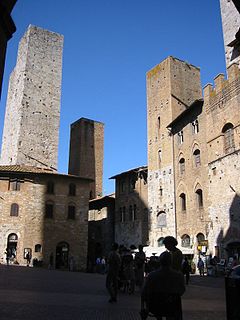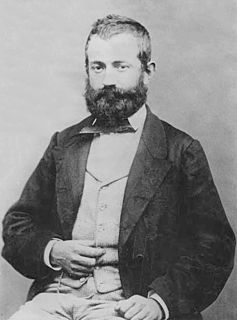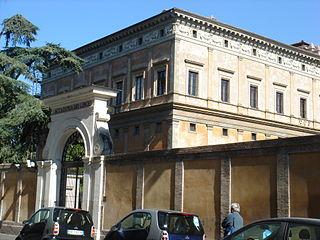"Edda" is an Old Norse term that has been attributed by modern scholars to the collective of two Medieval Icelandic literary works: what is now known as the Prose Edda and an older collection of poems without an original title now known as the Poetic Edda. The term historically referred only to the Prose Edda, but this since has fallen out of use because of the confusion with the other work. Both works were written down in Iceland during the 13th century in Icelandic, although they contain material from earlier traditional sources, reaching into the Viking Age. The books are the main sources of medieval skaldic tradition in Iceland and Norse mythology.

A manuscript was, traditionally, any document that is written by hand -- or, once practical typewriters became available, typewritten -- as opposed to being mechanically printed or reproduced in some indirect or automated way. More recently, the term has come to be understood to further include any written, typed, or word-processed copy of an author's work, as distinguished from its rendition as a printed version of the same. Before the arrival of printing, all documents and books were manuscripts. Manuscripts are not defined by their contents, which may combine writing with mathematical calculations, maps, explanatory figures or illustrations. Manuscripts may be in book form, scrolls or in codex format. Illuminated manuscripts are enriched with pictures, border decorations, elaborately embossed initial letters or full-page illustrations. A document should be at least 75 years old to be considered a manuscript.

The Vulgate is a late-4th-century Latin translation of the Bible that became the Catholic Church's officially promulgated Latin version of the Bible during the 16th century. The translation was largely the work of Jerome, who in 382 had been commissioned by Pope Damasus I to revise the Vetus Latina Gospels then in use by the Roman Church. Jerome, on his own initiative, extended this work of revision and translation to include most of the books of the Bible, and once published, the new version was widely adopted and eventually eclipsed the Vetus Latina; so that by the 13th century, it had taken over from the former version the appellation of versio vulgata or vulgata for short, and in Greek as βουλγάτα ("Voulgata").
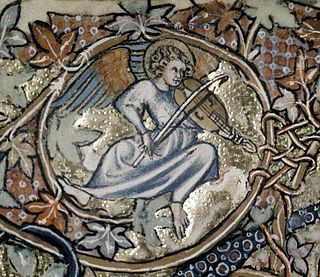
The vielle is a European bowed stringed instrument used in the Medieval period, similar to a modern violin but with a somewhat longer and deeper body, three to five gut strings, and a leaf-shaped pegbox with frontal tuning pegs, sometimes with a figure-8 shaped body. Whatever external form they had, the box-soundchest consisted of back and belly joined by ribs, which experience has shown to be the construction for bowed instruments. The most common shape given to the earliest vielles in France was an oval, which with its modifications remained in favour until the Italian lira da braccio asserted itself as the better type, leading to the violin.

The Robertsbridge Codex (1360) is a music manuscript of the 14th century. It contains the earliest surviving music written specifically for keyboard.
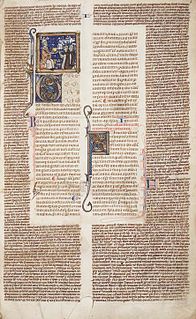
The scholars of the 11th and 12th century legal schools in Italy, France and Germany are identified as glossators in a specific sense. They studied Roman law based on the Digesta, the Codex of Justinian, the Authenticum, and his law manual, the Institutiones Iustiniani, compiled together in the Corpus Iuris Civilis. Their work transformed the inherited ancient texts into a living tradition of medieval Roman law.

Codicology is the study of codices or manuscript books written on parchment as physical objects. It is often referred to as 'the archaeology of the book', concerning itself with the materials, and techniques used to make books, including their binding.
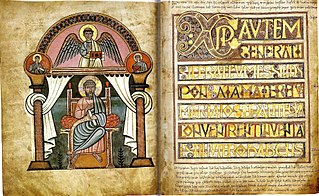
The Stockholm Codex Aureus is a Gospel book written in the mid-eighth century in Southumbria, probably in Canterbury, whose decoration combines Insular and Italian elements. Southumbria produced a number of important illuminated manuscripts during the eighth and early ninth centuries, including the Vespasian Psalter, the Stockholm Codex Aureus, three Mercian prayer books, the Tiberius Bede and the Royal Bible.

The Austrian National Library is the largest library in Austria, with more than 12 million items in its various collections. The library is located in the Neue Burg Wing of the Hofburg in center of Vienna. Since 2005, some of the collections have been relocated within the baroque structure of the Palais Mollard-Clary. Founded by the Habsburgs, the library was originally called the Imperial Court Library ; the change to the current name occurred in 1920. The library complex includes four museums, as well as multiple special collections and archives.

The Squarcialupi Codex is an illuminated manuscript compiled in Florence, Italy in the early 15th century. It is the single largest primary source of music of the 14th-century Italian Trecento.
The parchment codex called Littera Florentina is the closest survivor to an official version of the Digest of Roman law promulgated by Justinian I in 530–533.
The Rossi Codex is a music manuscript collection of the 14th century. The manuscript is presently divided into two sections, one in the Vatican Library and another, smaller section in the Northern Italian town of Ostiglia. The codex contains 37 secular works including madrigals, cacce and, uniquely among trecento sources, monophonic ballatas. The codex is of great interest for trecento musicologists because for many years it was considered the earliest source of fourteenth-century Italian music. Although other pre-1380 sources of secular, polyphonic, Italian music have now been identified, none are nearly so extensive as the Rossi Codex.

The Trecento was a period of vigorous activity in Italy in the arts, including painting, architecture, literature, and music. The music of the Trecento paralleled the achievements in the other arts in many ways, for example, in pioneering new forms of expression, especially in secular song in the vernacular language, Italian. In these regards, the music of the Trecento may seem more to be a Renaissance phenomenon; however, the predominant musical language was more closely related to that of the late Middle Ages, and musicologists generally classify the Trecento as the end of the medieval era. Trecento means "three hundred" in Italian but is usually used to refer to the 1300s. However, the greatest flowering of music in the Trecento happened late in the century, and the period is usually extended to include music up to around 1420.

Santo Stefano Belbo is a comune (municipality) in the Province of Cuneo in the Italian region Piedmont, located 60 km (37 mi) southeast of Turin and 60 km (37 mi) northeast of Cuneo.
Codex Corbiensis, according to Bruce Metzger, is a mutilated copy of the four Gospels, of the fifth or sixth century, formerly belonging to the monastery of Corbey, near Amiens, and now in the Bibliothèque Nationale at Paris. It contains a form of text akin to that preserved in Codex Vercellensis and Codex Veronensis.. Alternatively, it may have been produced in the famous scriptorium of Corbie Abbey in the 9th century and is now held in the Russian National Library, Saint Petersburg .
The manuscript includes a copy of an Old Latin version of the Epistle of James, without lacunae.
Bartolomeo Gastaldi was an Italian geologist and palæontologist, and one of the founders of the Club Alpino Italiano.

The Biblioteca Estense, was the family library of the dukes of Este. Dating to at least the 14th century, it was largely enriched during Ferrara's Renaissance, and finally established in Modena in the beginning of the 17th century. It is one of the most important libraries in Italy. The library is located in the Palazzo del Musei, Largo Sant'Agostino 337.

The Hedwig Codex, also known as the Codex of Lubin, is a medieval illuminated manuscript from the mid-14th century which through its sixty-one coloured drawings and inscriptions in "comics' style" tells the life story of saint Hedwig of Silesia, spouse of the Silesian Piast duke Henry the Bearded, her family and events related to her canonization (1267). This art piece, a fine example of Central European Gothic art, is valued especially for its depictions of the Tartar invasion of Europe (Silesia).



